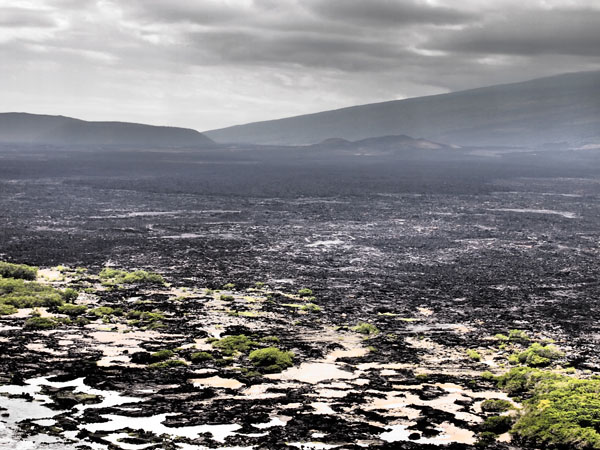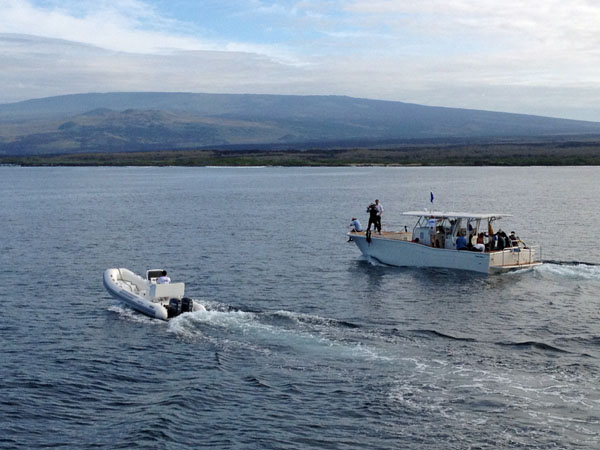The last day of research brought us to Urvina Bay on the west side of Isabela Island. In passing from Pueto Ayora around the southern end of Isabela, we followed the same route that Darwin took aboard the Beagle in 1835. In his book The Voyage of the Beagle, he wrote how the signs of recent volcanic activity were everywhere in these young western islands:
SEPTEMBER 29, 1835. We doubled the south-west extremity of Albemarle [Isabela] Island, and the next day were nearly becalmed between it and Narborough [Fernandina] Island. Both are covered with immense deluges of black naked lava, which have flowed either over the rims of the great caldrons, like pitch over the rim of a pot in which it has been boiled, or have burst forth from smaller orifices on the flanks; in their descent they have spread over miles of the sea-coast. On both of these islands eruptions are known to have taken place; and in Albemarle we saw a small jet of smoke curling from the summit of one of the great craters.

Urvina is between Darwin and Alcedo Volcanoes, across the Canal Bolívar from Fernandina. It was just another cove in 1835, but that changed dramatically a little over a century later. In 1954, the crew of a passing ship noticed a strange new white beach at Urvina. On closer investigation they found an entire stretch of shoreline—coral, fish, and all—had been suddenly lifted six meters above sea level by volcanic pressure underneath. It had happened so recently that fish were still flapping in puddles of seawater.

Now Urvina is a popular visitor landing site, with the strange sight of large coral skeletons sitting on dry land surrounded by the bones of marine animals and the shells of dozens of sea turtles. On the shallow morning dive, we saw a both Porites and Psammocora corals, along with a seahorse and a sea turtle feeding on the abundant algae beds. Most of the group came up shivering from the second, deeper dive, which was colder thanks to the upwelling current from the west. This deeper area probably gets too cold to support corals during certain times of year, when the water temperature drops below 15C. (The shallower area never gets that cold, hence the small populations of coral closer to shore.)

Then it was time to clean, sort and dry gear, and pack up as the Golden Shadow motored overnight to Baltra and the airport. The general feeling on board is that this was a successful mission, especially the extended stay at Wolf and Darwin. (Not many research ships have the resources to anchor there with so many people and gear for a solid week.) As Peter said yesterday, even though the coral communities in the southern Galapagos Islands have a long way to go to reach their pre-’82/83 conditions, the corals around the northern islands seem to be recovering, slowly, but surely. In terms of their long-term survival, future El Niño events could make all the difference.
As we leave Urvina, the ship now has a long Pacific crossing ahead as the Global Reef Expedition continues this fall in French Polynesia. Thanks for following our mission to the Galapagos. Tune in soon for the next leg of our round-the-world journey.
(Photos/Images by: 1 & 3 Sam Purkis, 2 Julian Smith)
To follow along and see more photos, please visit us on Facebook! You can also follow the expedition on our Global Reef Expedition page, where there is more information about our research and team members.